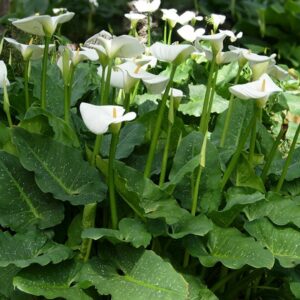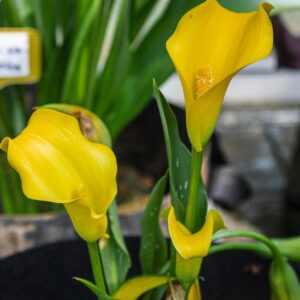Your cart is currently empty!
Behold the Graceful Elegance of Blooming Calla Lilies: A Comprehensive Guide

Introduction
Calla lilies, renowned for their elegant funnel-shaped blooms and sword-like foliage, have captivated gardeners and flower enthusiasts for centuries. This guide delves into the captivating world of blooming calla lilies, offering insights into their growth, care, and breathtaking beauty.
Varieties of Calla Lilies
The genus Calla encompasses a diversity of species, each offering unique characteristics:
- Zantedeschia aethiopica (White Calla Lily): Known for its pure white blooms and lush foliage, it symbolizes purity and elegance.
- Zantedeschia elliottiana (Yellow Calla Lily): Exudes vibrant yellow blooms, creating a cheerful and sunny atmosphere in gardens.
- Zantedeschia rehmannii (Pink Calla Lily): Features delicate pink blossoms, adding a touch of grace and femininity to any landscape.
- Zantedeschia albomaculata (Spotted Calla Lily): Bears striking white blooms adorned with purple spots, creating an eye-catching display.
Cultivation and Care
Light Requirements
Calla lilies thrive in bright, indirect light. Avoid prolonged exposure to direct sunlight, as it can scorch the leaves.
Soil Conditions
Well-drained, loamy soil rich in organic matter is ideal. Regular mulching helps retain moisture and regulate soil temperature.
Water Requirements
- During active growth, keep the soil consistently moist but not waterlogged.
- Reduce watering in winter or when the plant is dormant.
Fertilizer
- Fertilize monthly during the growing season with a balanced liquid fertilizer.
- Avoid over-fertilizing, which can lead to leaf burn.
Propagation
Calla lilies can be propagated through:
Rhizome Division
- Divide healthy rhizomes into smaller sections in spring.
- Plant the divisions in well-drained soil and keep them moist.
Seed Germination
- Sow seeds in a warm, well-lit environment.
- Keep the soil moist and maintain a temperature between 68-77°F (20-25°C).
Troubleshooting
Yellowing Leaves
- Overwatering or poor drainage
- Nutrient deficiency (especially nitrogen)
Brown Leaf Tips
- Underwatering
- Excessive exposure to sunlight
Pest and Disease Management
- Aphids: Use insecticidal soap or neem oil to control.
- Thrips: Promote beneficial insects (e.g., ladybugs) and use horticultural oils if necessary.
- Root rot: Avoid overwatering and provide well-drained soil. Treat with fungicides if infection occurs.
Floral Arrangements
Calla lilies are highly sought after in floral arrangements due to their striking blooms and long vase life:
- Pair them with roses, orchids, or lilies for a classic and elegant bouquet.
- Create a bold statement by arranging them in monochromatic vases.
- Incorporate their lush foliage into greenery arrangements to add texture and dimension.
Conclusion
Blooming calla lilies are a testament to nature’s beauty and elegance. With proper care and attention, these graceful plants will reward you with their stunning blooms for years to come. Embrace their charm and incorporate them into your gardens, homes, and floral arrangements, where they will bring joy and tranquility alike.








Leave a Reply